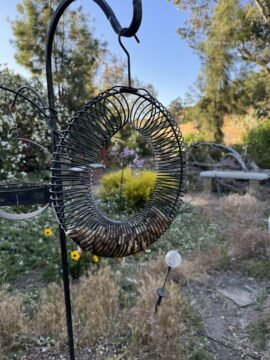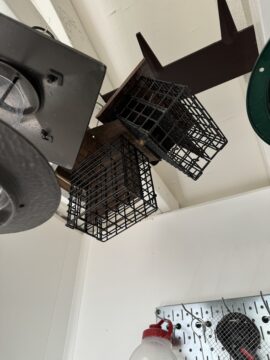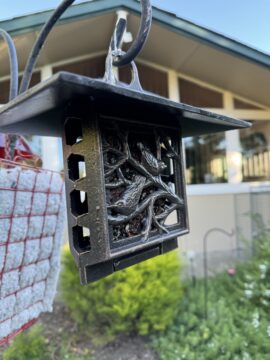There are a bazillion bird feeders on the market and about half them are awful; they’re either downright dangerous and not suitable for their purposes, or super-fiddly and annoying to keep clean. The other half are decent enough, but to be truly a great bird feeder, it should be easy to fill, suitably-sized, and above all, easy to clean.
Now we employ several strategies to keep our feeders clean and prevent the spread of any avian diseases like pox and salmonella. First, all feeders are cleaned at least once a week, and while they are busy drying, we have a duplicate feeder we can use in its place. We use plastic rainguards/squirrel baffles above most of our column feeders, and this minimizes the chances of bird poop getting into the seed and spreading diseases. Finally, we keep the various water sources we provide clean, and all of them can be refilled with the Rachio app, as they are on independent valves and circuits from the rest of the irrigation.
So what feeders do we like the most, after years of fussing over what works where? First off, I should mention that we don’t like anything that can swing about a lot, as we have this thing called wind. A little bit of swinging in 30mph wind is fine, but a lot of swinging leads to things flying away or into other things. That said, here are our top choices:
For small songbirds like finches and grossbeaks, the Droll Yankee Classic Sunflower/Mixed Seed Bird Feeder, Ring Pull is by far the best feeder ever. Six ports with perches and so, so easy to clean. You just pull the lid up and over to the side, pull the center pin out by the ring, and all the metal bits tumble aside and you can quickly and easily clean everything. To provide for larger birds like doves and our Mule Deer, we use a Whitehall seed feeder, which is a bit heavy but it takes a very strong wind to knock it about, so it works well out by the edge of the wall. And when the Mule Deer eventually damage the plastic column, a quick call to the company and $5 will get you a replacement in under a week. Sometimes we swap out the Whitehall for a PerkyPet Copper Panorama Feeder which, while not as hefty, serves up the same seed very well; in fact, during the non-breeding season, we use these in more sheltered spots instead of the jam feeders detailed below.
For smaller seeds, we rely on the Perky-Pet Straight-Sided Mesh Tube. Its big advantage is that both the bottom platform and top dome shield easily twist off, which not only makes cleaning a breeze, but the dome shields the feeder from bird feces. In a pinch I have another option, but it requires a rain shield when used. We also use some similar smaller models like our favorite, More Birds Little-Bit Finch, up under the eaves of my office, as putting feeders close to windows helps birds learn that windows are hard surfaces they should not try to fly into. (We also have invested much time and energy into installing CollidEscape tape on most of our windows, which reduced collisions by about 95%!)
Then for mealworms, I adore the Mosaic Bistro Bird Feeder, because all the dust from freeze dried mealworms just sifts away, and the removable perch is awesome. On top of all that, it’s a rather fetching feeder, very sturdy and super-easy to clean.
And instead of a platform feeder, which creates way too much mess and encourages the ground squirrels to come close to the house, we instead offer seed in a Woodlink Copper feeder. It sits on the bench that is the only surviving remnant of the old deck outside my office, and the surrounding cage means only small birds can reach the seed, but plenty of seed is scattered for our ground feeders and the proximity to the house means rodents don’t frequent it. While we do deter ground squirrels from coming near the house, the wee pocket gophers often frequent the outskirts of the garden to feast on fallen morsels.
Finally, for feeding nuts to the squirrels and jays and other bullies, we adore the Songbird Essentials Whole Peanut Black Wreath feeders and the Birds Choice Magnet Mesh Bird Feeder (with a bit of crafty modification that I’ll cover in the next post).
For our liquid offerings, we have standardized on two feeders: the Perky-Pet Starglow Vintage Glass and the More Birds 20oz Vintage, and for the gooey jam, we use the Mosaic Birds Side By Side Poppy Feeder and a single-cup version also by Mosaic. During the non-breeding season, when all our orioles are down south, we use the simple Starglows to keep our hummers topped up. They’re really easy to clean and while some people say they rust easily, we’ve never had that issue. Then when the orioles arrive in March, we switch those out for the larger More Birds feeders, which have perches. The only two downsides: the flexible orange flowers are often plucked out by greedy grosbeaks and we have to search the undergrowth for them (and the flowers eventually die, but thankfully replacements are inexpensive and easy to get); and at some point recently, the company changed molds so only half our feeders seal properly with one set of bases, and we have to be careful when matching them lest all the sugar water leaks out five minutes after putting one out. Finally we use the Mosaic Poppy feeders to offer jam. Yes, you read that right; during the breeding season simple store-bought jam is in high demand, and we blow through about thirty-two ounces every week. Thankfully, simple generic grape jelly isn’t all that expensive.
And as mentioned in the previous post, we also have several of the three-port Nectar DOT window feeders. These suction to the windows and provide up close and personal time with our plethora of hummingbirds. And we also have some Mosaic Humble Hummingbird feeders that are always out on the edge of the garden.
We offer suet to birds via two feeder options: the simple More Birds double cake feeder and the Whitehall single cake feeder. Both are so very easy to clean, the Whitehall especially as it disassembles into three pieces, so even if the heat causes suet to ooze a bit, a quick scrub is all that is needed and it’s ready to be used again as soon as it dries.
Finally, we have an assortment of spares that are too useful with which to part, and a large collection of rain shields/squirrel baffles. For the shields we employ the same doubling up strategy, as cleaning them is just as important as keeping our feeders tidy. Some of our Shepard’s hooks also have metal baffles that are made to deter squirrels, but we primarily use them to shield the ground from some of the bird poop. Not all the poles have these baffles, but usually those with feeders frequented by the smaller birds have them. And for those wondering, most of our hooks are from Erva, as that manufacturer allows you to add hanging points to the pole without compromising the pole’s strength; so many competitors’ systems are very rickety and a strong gust of wind can easily rip them apart.

























